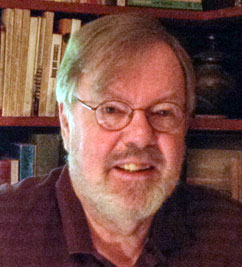Long-time WCER Researcher Nystrand Returns for One More CLASS
September 24, 2013

Martin Nystrand
Martin Nystrand first came to WCER in 1984, when he brought his expertise in dialogic organization of discourse into a multi-pronged, multi-disciplinary study of classroom conversations between students and teachers. Now, almost 30 years later, Nystrand has come out of retirement to work on a project that will create a technological tool that will make data collection inside classrooms cheaper and easier for the next generation of education researchers.
In his initial tenure at WCER, Nystrand, a professor of English with a focus in composition and rhetoric, teamed with sociologist and fellow WCER researcher Adam Gamoram (who served as WCER director until recently) to investigate the role of classroom interaction in student learning. Nystrand and Gamoran co-authored Opening Dialogue: Understanding the Dynamics of Language and Learning in the English Classroom (Teachers College Press, 1997), which described the first large-scale empirical study to document the role of open classroom discussion in student learning.
During the data collection phase of the project that resulted in Opening Dialogue, Nystrand and Gamoran studied 112 eighth- and ninth- grade language arts and English classes comprising 1,100 students for each of two years. Their numerous discoveries included the finding that open-ended discussion about literature correlated highly with student achievement in those classes.
“Just as interesting was our finding that it didn’t matter whether students talked or not during those discussions,” Nystrand said. “All students in the classroom as the discussion was taking place benefited.”
Through his years of research, Nystrand became frustrated at the time and resources it took to gather quality data inside classrooms. In addition to the countless hours researchers had to spend in class taking notes and outside of class distilling those notes into usable data, the presence of an outsider in the classrooms resulted in occasional disruptions and distractions for both students and teachers, as well as the potential, though inadvertent, violation of student identity.
In response to those concerns, in 1988, Nystrand created what eventually became the Classroom Assessment Scoring System (CLASS), an observation instrument that assesses and codes teacher-child interactions. The computer program, designed for Microsoft’s Windows operating system, assisted researchers in analyzing the kinds of questions teachers and students ask and patterns of discourse in unfolding lessons.
CLASS underwent three updates (CLASS 2.0, 3.0, and 4.0) through Nystrand’s partnership with three national research centers. Since its creation, CLASS has been used in numerous large-scale empirical studies across the United States, including Nystrand’s collaboration with Gamoran that proved significant correlation between open-ended classroom discourse and student achievement in middle and high school reading and literature classes.
In 2007, Nystrand retired as a professor emeritus at the University of Wisconsin and as a WCER researcher. However, recent technological advances that made possible the creation of a new version of CLASS tempted Nystrand out of retirement.
“With the new technology, for the first time, the program can be completely autonomous – it will not require anybody there to operate it,” Nystrand said. “Ideally, it could function as mobile technology, such as a smartphone app that teachers themselves could set up in their classroom, plug into a couple of microphones, and run without thinking about it during their instruction. It’s something that I couldn’t imagine in my wildest dream when I first created CLASS.”
Earlier this year, Nystrand received $1.6 million from the U.S. Department of Education’s Institute of Educational Sciences to be used through 2016 to collaborate with colleagues at the Institute for Intelligent Systems to create CLASS 5.0. The grant proposal calls for the incorporation of cutting-edge research in speech recognition, discourse classification, computational linguistics, and natural language understanding into the new program.
“With the incorporation of all the new research that has been done since the last CLASS update, I’m positive (CLASS 5.0) will revolutionize classroom research,” Nystrand predicted.
It will also make collecting data easier and cheaper. Currently, researchers looking to collect classroom data must send researchers into each classroom in person, making notes and recording audio or video, which is reviewed and coded afterwards. The process is “very cumbersome and expensive,” according to Nystrand.
“With CLASS 5.0, no observer or research assistant data collector is needed,” Nystrand said. “The best part is, there is nothing intrusive in classrooms, and no danger of violation of teacher or student identity.“
Nystrand said the new CLASS software has the potential to open up research avenues that didn’t previously exist. For example, “it can be used for professional development by schools, or by teachers themselves to gather feedback for self-improvement,” Nystrand said
Nystrand, who has demonstrated a lifelong passion for his work, culminating in the 2011 Distinguished Lifetime Research Award from the National Conference on Research in Language and Literacy, said he did not hesitate to come out of retirement to work on such an important venture.
“As you can tell, I’m very excited about this project,” he said. “I can barely imagine what its possibilities are.”


